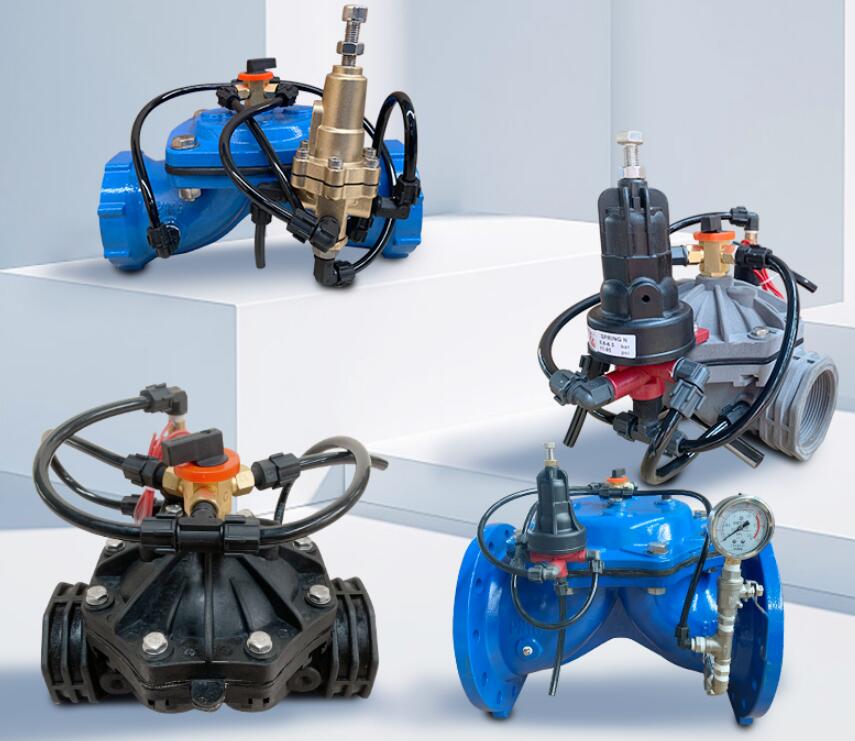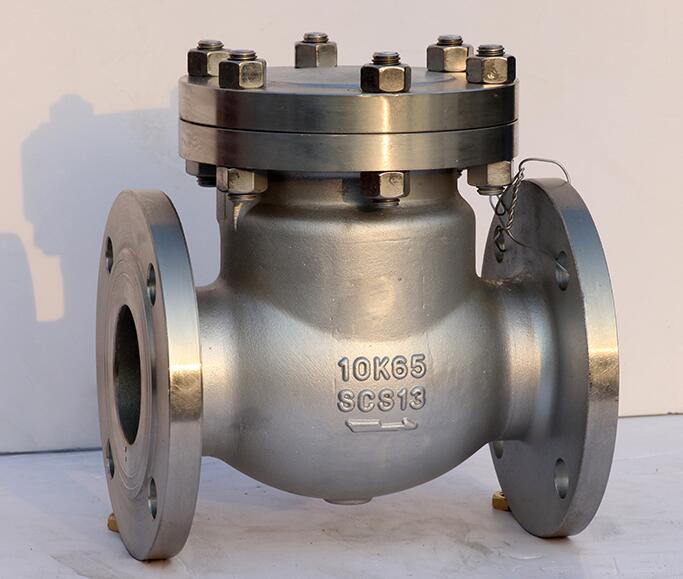Односторонні клапани Також називається зворотні клапани або клапани, що не перевозяться. Це клапан, де рідина може текти лише по вході, а середовище на виході не може текти назад.
Він використовує в гідравлічних системах для запобігання зворотного потоку нафти, або в пневматичних системах для запобігання зворотного потоку стисненого повітря. Вони відіграють вирішальну роль у різних галузях, забезпечуючи однонаправлений потік речовин у трубопроводах, системи, та обладнання, тим самим підвищуючи безпеку, ефективність, та продуктивність.

Один із способів клапанів має прямий і правий тип другого
Прямий тип в один бік
з різьбовим з'єднанням, встановленим у трубопроводі.
Прямий односторонній клапан-це тип клапана, який дозволяє рідині або газу протікати лише в одному напрямку, запобігаючи зворотному потоку. Він має прямий дизайн, полегшення безперешкодного проходження потоку для підвищення ефективності та мінімального падіння тиску. Цей клапан зазвичай використовується в додатках, де підтримка спрямованого потоку є критичним, наприклад, у сантехнічних системах, зрошення, та промислові процеси.
Правий кут в один бік типу має три форми
Ниткове з'єднання, зварене з'єднання та фланцеве з'єднання.
Правий кут односторонній клапан-це тип клапана, призначений для регулювання потоку рідини або газу в одному напрямку, запобігаючи зворотному потоку. Він має конфігурацію L-подібної або правої кута, що дозволяє встановити в тісних просторах або там, де потрібно перпендикулярне з'єднання. Цей клапан зазвичай використовується в різних галузях, включаючи автомобіль, Медичні пристрої, та системи HVAC, де існують обмеження простору або конкретні вимоги до встановлення.
Типи клапана в один бік

Класифікація на основі проектування та механізму
Типи контрольних клапана є: тип весни, Тип гравітації, тип гойдалки, Пластиковий тип діафрагми. Відповідно до структури: Підніміть контрольні клапани, клапани клапанів метеликів, поворотні зворотні клапани, Кульовий контрольний клапан та клапанний клапан.
- Підняття контрольного клапана: Розділений на вертикальну перевірку, горизонтальна перевірка.
- Клапан перевірки гойдалки: Розділений на одноразову перевірку, Двічі зворотні клапани, багатокласна перевірка.
- Клапани з м'ячем: Кулькові зворотні клапани - це механічні пристрої, що використовуються для управління потоком рідин або газів у трубопроводах, дозволяючи потік в одному напрямку, запобігаючи зворотному потоку у зворотному напрямку. Вони складаються з сферичної кулі всередині тіла клапана, який вільно рухається, щоб дозволити потік, коли тиск на вхідній стороні вище, ніж сторона виходу. Коли потік повертається, Куля рухається, щоб перекрити прохід, запобігання зворотного потоку.
- Клапанні зворотні клапани: Клапанні зворотні клапани - це механічні пристрої, розроблені для регулювання потоку рідини або газу в трубопроводах, дозволяючи потік в одному напрямку, запобігаючи зворотному потоку у зворотному напрямку. Вони мають навісний клаптя або диск, який відкривається в напрямку потоку і закривається, щоб блокувати зворотне потік. Ця конструкція дозволяє ефективно керувати потоком, запобігання скасуванню рідини або газу та забезпечення цілісності системи трубопроводу. Клапанні зворотні клапани широко використовуються в різних галузях через їх надійність, Низькі вимоги до обслуговування, та ефективність у запобіганні зворотного потоку.
ПЕРЕВІРНІ КЛАПАНИ відповідно до форми з'єднання: Нитковий тип перевірки, Зварений тип перевірки, Тип перевірки фланця.
Класифікація на основі програми
| Середній тип | Рекомендовані матеріали |
| Корозійні рідини | Нержавіюча сталь, Лепка сталь |
| Сильні кислоти та луги | PTFE (політетрафторетилен) |
| Високотемпературна пара | Спеціальні теплостійкі сплави |
- Гідравлічні зворотні клапани є важливими компонентами в гідравлічних системах, Розроблений для управління потоком рідини в одному напрямку, запобігаючи зворотному потоку. Вони використовують внутрішні механізми, такі як пружинні диски або попки, щоб рідина дозволила текти в одному напрямку, при автоматичному закритті, щоб блокувати потік у зворотному напрямку. Ці клапани забезпечують цілісність та ефективність гідравлічних систем шляхом запобігання зворотного потоку рідини, що може завдати шкоди або несправності.
- Пневматичні зворотні клапани є пристроями, що використовуються в пневматичних системах для регулювання потоку стисненого повітря або газів в одному напрямку, запобігаючи зворотному потоку. Вони працюють за допомогою внутрішніх механізмів, таких як пружинні диски або щеп, які відкриваються, щоб дозволити повітряний потік в одному напрямку і близько блокувати повітряний потік у зворотному напрямку. Ці клапани забезпечують належне функціонування пневматичних систем, запобігаючи зворотному потоку, що може порушити операції або пошкодити обладнання.
- Медичні зворотні клапани є спеціалізованими компонентами, які використовуються в медичних пристроях та обладнаннях для контролю над потоком рідин або газів в одному напрямку, запобігаючи зворотному потоку. Ці клапани мають вирішальне значення для підтримки цілісності медичних систем, Забезпечення належної доставки ліків, гази, або рідини пацієнтам під час процедур або лікування. Вони працюють за допомогою таких механізмів, як м'яч, діафрагма, або пружинні конструкції, що дозволяють потік в одному напрямку, блокуючи потік у зворотному напрямку.
- Клапани качки є односторонні пасивні зворотні клапани, призначені для того, щоб забезпечити рух рідини або газу в одному напрямку, запобігаючи зворотному потоку. Їх унікальна форма нагадує законопроект качки, Звідси назва. Ці клапани складаються з гнучкого еластомерного матеріалу, наприклад, силікон або гума, утворений у конічну форму, яка природно залишається закритим, коли тиск не застосовується. Коли рідина або газ тече в потрібному напрямку, тиск відкриває клапан, Дозвіл на прохід. Проте, Коли потік зупиняється або повертається, Еластичність клапана змушує його закрити, запобігання зворотного потоку. Клапани качки знаходять додатки в різних галузях, включаючи медичні пристрої, очищення стічних вод, автомобільний, і аерокосмічний, де надійне одностороннє управління потоком є важливим.
- Клапани з полегшення тиску Чи є пристрої безпеки, що використовуються для захисту обладнання або систем від надмірного накопичення тиску, автоматично відкриваючи, щоб звільнити зайвий тиск. Вони працюють, відчуваючи тиск у системі і, Коли він перевищує заздалегідь визначений поріг, вони відкриваються, щоб дозволити вивільнення рідини або газу, тим самим запобігаючи шкоді або катастрофічній невдачі. Клапани для зняття тиску є вирішальними компонентами в різних галузях промисловості, включаючи нафту і газ, хімічна обробка, вироблення енергії, та очищення води, Там, де підтримка безпечного експлуатаційного тиску є важливим. Вони приходять у різних конструкціях, включаючи навантажений весняним, пілотний, і врівноважений сильфон, кожен підходить для конкретних застосувань та діапазонів тиску.
Звичайний тип перевірки
Звичайні контрольні структури дозволяють потік рідини лише в одному напрямку. Тиск відкриття вперед-це, як правило, 0,03-0,05 мпА.
Основні програми звичайних односторонніх клапанів:
- Клапан зазвичай встановлений на виході насоса. Тому що удар тиску вплине на нормальну роботу насоса. І це запобігає, що насос не працює, коли системний зворотний потік масла.
- Односторонні клапани також здатні працювати в окремих камерах високого та низького тиску.
- Типи односторонніх клапанів є: односторонні дросельні клапани, Односторонні клапани, що зменшують тиск, односторонні клапани послідовності.
- У клапанах зворотного тиску, зворотні клапани встановлюють шлях повернення.
Прямий тип
Прямі зворотні клапани в напрямку потоку масла та напрямок осі клапана однаковий.
Клапани з з'єднання труби, Масляний порт такого клапана може бути підключений до масляної труби через з'єднувач труби. Вага його корпусу клапана залежить від опори труби, Тож об'єм клапана не може бути занадто великим і занадто важким.
Правий кут в один бік клапанів
Вісь входу та виходу з правого кутового зворотного клапанів перпендикулярна до осі тіла клапана.
Міркування відбору
При виборі зворотного клапана, Необхідно враховувати кілька ключових факторів, щоб забезпечити оптимальну продуктивність та надійність у конкретному додатку. Ці фактори включають робочий тиск, вимоги до потоку, Медіа характеристики, Діапазон температури, та вибір матеріалів. Деталі наступні:
- Робочий тиск є основою для відбору. Робочий тиск зворотного клапана повинен відповідати максимальному робочому тиску системи, щоб переконатися, що клапан може підтримувати стабільне ущільнення під високим тиском. Наприклад, У обладнання для різання струменя високого тиску, Робочий тиск зворотного клапана повинен досягти сотень МПА, щоб запобігти зворотному потоку води високого тиску.
- Вимоги до потоку безпосередньо впливає на розмір та швидкість реакції клапана. Неправильний відбір може призвести до втрати тиску або затримки реакції. Для великих застосувань потоку, наприклад, великі гідравлічні системи, Можливо, знадобиться вибрати спеціально розроблений великим потоком гідравлічно контрольованого зворотного клапана з номінальним потоком понад 1000 л/хв.
- Розгляд Медіа характеристики особливо важливо. Різні носії мають різні вимоги до матеріалів клапана та ущільнювачів: список 1
- Діапазон температури є ще одним ключовим параметром. Вибір матеріалів клапана та ущільнювачів повинен враховувати робочу температуру, щоб переконатися, що вони зможуть підтримувати хороші показники в екстремальних умовах. Наприклад, Деякі спеціальні зворотні клапани можуть працювати в надзвичайно широкому температурному діапазоні від -196 ° C до +850 ° C[1].
- В додаток, Метод кріплення і зручність обслуговування потрібно враховувати. Вибір різьбового з'єднання, Фланцеве з'єднання або зварювання повинно відповідати системному інтерфейсу. Замінність носінних деталей також вплине на довгострокову експлуатаційну вартість.
Міркування встановлення
Під час встановлення зворотного клапана, Окрім вибору напрямку та положення, Існує деякі ключові міркування, які потребують особливої уваги, щоб забезпечити належним чином клапан та максимізувати його продуктивність. Ці міркування такі:
1.Герметична перевірка : Після встановлення, Комплексна герметична перевірка повинна бути виконана на з'єднанні між зворотним клапані та трубопроводом. Це можна зробити, застосовуючи мильну воду або спеціальну рідину виявлення витоку, щоб спостерігати, чи є бульбашки чи ненормальні витоки. Для систем високого тиску, Можливо, знадобиться використовувати професійне обладнання для тестування тиску для перевірки продуктивності ущільнення.
2.Контроль вібрації : У деяких програмах, зворотний клапан може призвести до значної вібрації. Щоб зменшити цю вібрацію, Можна вжити наступних заходів:
- Використовуйте гнучкі роз'єми або вібраційні демпфери для підключення зворотного клапана та системи трубопроводу
- Встановіть демпфер або глушник біля зворотного клапана
- Відрегулюйте пружину попереднє завантаження зворотного клапана за потребою
3.Обхідна установка : В деяких критичних системах, Рекомендується встановити посібник для обхідного клапана поруч із зворотним клапаном. Переваги цього включають:
- Зручна аварійна операція
- Коли зворотний клапан потрібно відремонтувати або замінити, Вся система може діяти без зупинки
- Поліпшення загальної надійності та безпеки системи
4.Підтримка трубопроводу: Для великих або важких зворотних клапанів, Поруч із місця встановлення повинна бути надана достатня підтримка трубопроводів. Розумна підтримка може не лише зменшити напругу на зворотний клапан, але також зменшити вібрацію трубопроводу, тим самим покращуючи стабільність та життя всієї системи.
5.Електричне з'єднання: Для зворотних клапанів з функціями електричного управління (наприклад, електричні зворотні клапани), Слід зазначити наступні моменти:
- При необхідності встановіть пристрої захисту від блискавки та захисту від перенапруг
- Переконайтесь, що електричне з'єднання відповідає відповідним стандартам безпеки
- Використовуйте кабелі та роз'єми відповідних специфікацій
Опис нових тенденцій та інновацій клапана One Seal

Нові тенденції та нововведення в технології одностороннього клапана означають трансформаційну фазу в механізмів управління рідиною. Ці досягнення характеризуються переходом до розумніших, більш ефективний, та екологічно стійкі рішення.
- Розумний клапан технології:
- Інтеграція датчиків та приводів для моніторингу та контролю в режимі реального часу.
- Впровадження алгоритмів прогнозного обслуговування для проактивного обслуговування.
- Стійкі матеріали:
- Прийняття екологічно чистих матеріалів, таких як полімери на основі біо-на основі вторинних металів.
- Розробка клапанів зі зменшенням екологічного сліду та покращеного життєвого циклу.
- Інтеграція з IoT:
- Підключення до Інтернету речей (IoT) Платформи для віддаленої роботи та аналітики даних.
- Використання хмарних рішень для централізованого управління та оптимізації.
- Підвищення продуктивності:
- Посилені можливості управління потоком для точного регулювання потоку рідини.
- Зниження падіння тиску та споживання енергії за допомогою інноваційних конструкцій.
- Адаптація до галузевих потреб:
- Налаштування проектів клапана для задоволення конкретних галузевих вимог та додатків.
- Індивідуальні рішення для складних середовищ, таких як високий тисок або корозійні умови.
Ці нові тенденції та інновації відображають прихильність галузі до ефективності, стійкість, та технологічний прогрес, Прокладка шляху для нової ери розчинів управління рідиною.
